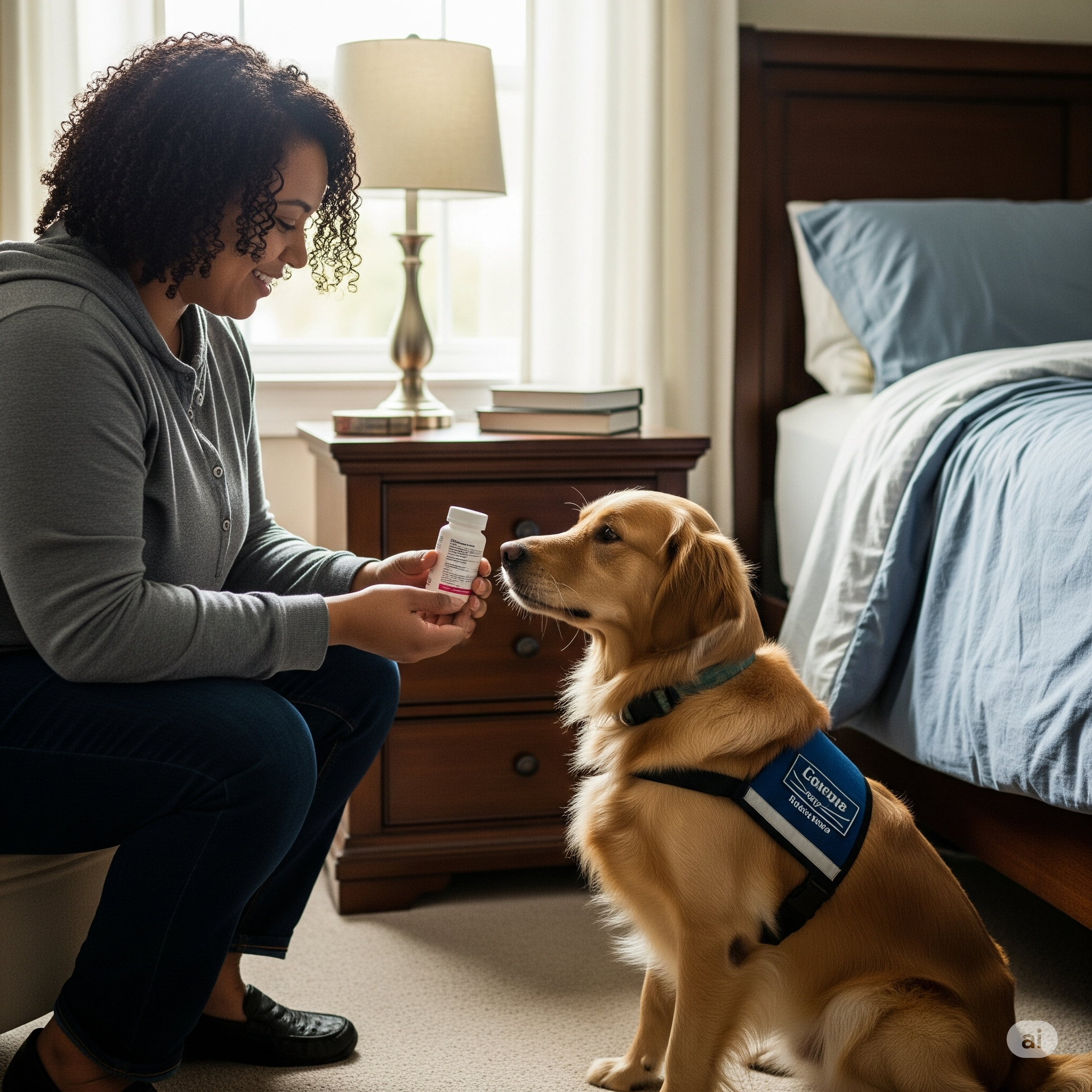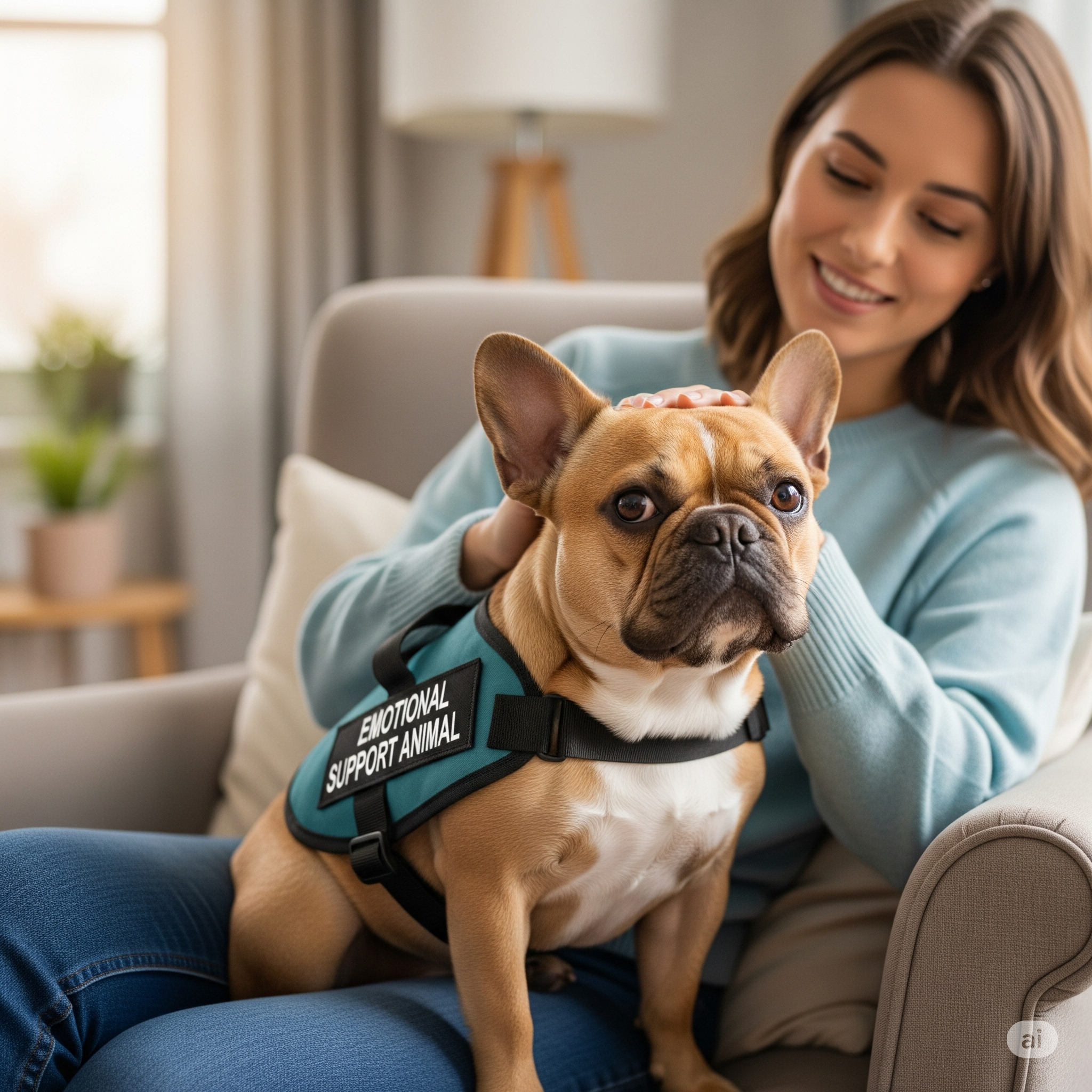For individuals living with mental health disabilities, a Psychiatric Service Dog (PSD) can be a life-changing partner, offering invaluable support through specifically trained tasks that mitigate their symptoms and enhance their independence. The bond forged during training, coupled with the personalized nature of at-home instruction, can create an exceptionally strong and effective service animal team.
We will explore the essential foundations of service dog training, identify crucial considerations before you begin, outline a step-by-step approach to task training relevant to psychiatric disabilities, address socialization and public access skills, and navigate potential challenges.
Understanding the Commitment: Is At-Home PSD Training Right for You?
Training your own PSD is a significant undertaking that requires time, patience, consistency, and a deep understanding of both your dog and your own disability-related needs. Before you begin, carefully consider the following:
Your Dog’s Temperament and Suitability:
- Temperament: Your dog should possess a calm, stable, and non-reactive temperament. They should not exhibit aggression, excessive fearfulness, or high levels of anxiety.
- Trainability: A willingness to learn and please is crucial. Look for a dog that enjoys training and responds well to positive reinforcement methods.
- Age and Health: Younger dogs (puppies or young adults) are generally easier to train. Ensure your dog is in good physical health and capable of handling the demands of training and service work.
- Breed Considerations: While any breed can potentially be a PSD, certain breeds are often recognized for their intelligence, trainability, and temperament suitable for service work (e.g., Labrador Retrievers, Golden Retrievers, Poodles). However, individual dog temperament is more critical than breed alone.
Your Capacity and Commitment:
- Time Investment: PSD training is a lengthy process that can take anywhere from 18 months to two years or more, requiring consistent daily training sessions.
- Consistency and Patience: Progress may not always be linear. You need to be patient, understanding, and consistent with your training methods.
- Knowledge and Resources: You will need to educate yourself on service dog training principles, positive reinforcement techniques, and task training specific to psychiatric disabilities. Access to reliable resources and potentially professional guidance is essential.
- Financial Considerations: While you’ll save on the cost of purchasing a fully trained service dog, you’ll still incur expenses for training equipment, high-value treats, veterinary care, and potentially professional training consultations.
- Emotional Resilience: There will be challenges and setbacks during the training process. Maintaining a positive and resilient attitude is crucial.
Ethical Considerations:
- Legitimate Need: Ensure you have a genuine psychiatric disability that substantially limits one or more major life activities and that the tasks your dog will be trained to perform will directly mitigate these limitations.
- Avoiding Misrepresentation: It is unethical and illegal to misrepresent a pet as a service animal. This undermines the legitimacy of genuine service dog teams and can create negative experiences for individuals who rely on them.
Laying the Foundation: Obedience and Basic Skills
Before embarking on specific psychiatric task training, your dog must have a solid foundation in basic obedience and essential skills. These form the building blocks for more complex tasks and ensure your dog is well-behaved and manageable in various environments.
Essential Obedience Commands:
- Sit: Responding reliably to the verbal cue and hand signal.
- Stay: Holding a sit, down, or stand position for increasing durations and distractions.
- Down: Lying down on cue.
- Come (Recall): Returning immediately and reliably when called, regardless of distractions. This is a critical safety command.
- Leave It: Ignoring or dropping an item on command. This is important for preventing your dog from picking up potentially harmful objects in public.
- Drop It: Releasing an item held in the mouth on command.
- Loose-Leash Walking: Walking calmly by your side without pulling on the leash.
Essential Public Access Skills (even before formal public access training):
- Potty Training: Being reliably house-trained and able to eliminate appropriately outdoors.
- Crate Training (Optional but Recommended): Providing a safe and secure den for your dog.
- Quiet Behavior: Remaining calm and quiet in various environments, without excessive barking, whining, or other disruptive behaviors.
- Neutrality Towards People and Animals: Showing polite indifference to strangers and other animals.
Training Methods:
- Positive Reinforcement: This is the most effective and ethical method for service dog training. Reward desired behaviors with high-value treats, praise, toys, or other motivators. Avoid punishment-based methods, as they can damage your dog’s trust and hinder the training process.
- Consistency: Use clear and consistent cues and commands. Ensure everyone in the household uses the same signals and words.
- Short, Frequent Sessions: Keep training sessions short (5-10 minutes) and engaging, with multiple sessions throughout the day. This helps maintain your dog’s focus and enthusiasm.
- Gradual Progression: Start with simple steps in a quiet environment and gradually increase the difficulty, duration, and distractions as your dog progresses.
Task Training for Psychiatric Disabilities: Tailoring to Your Needs
Once your dog has a solid foundation in obedience, you can begin training specific tasks to address your individual psychiatric disability-related needs. The tasks will vary depending on your specific condition and symptoms. Here are some common examples of PSD tasks:
Anxiety and Panic Attack Support:
- Deep Pressure Therapy (DPT): Trained to lie across your lap, chest, or another part of your body to provide calming pressure during anxiety or panic attacks. This can be trained using cues like “pressure” or when the handler exhibits signs of distress.
- Tactile Stimulation/Nudging: Trained to nudge or paw at you to interrupt escalating anxiety or dissociation.
- Bringing Medication or Water: Trained to retrieve a specific item, such as a medication container or a bottle of water, upon a verbal cue or when the handler exhibits signs of distress.
- Leading to a Safe Place: Trained to guide you to a designated quiet or safe location when you feel overwhelmed or are having a panic attack. This requires teaching the dog to recognize cues of distress and to lead the handler to the pre-determined spot.
- Creating Space/Crowd Control: Trained to stand in front of or behind you in crowded environments to create a physical barrier and provide a sense of personal space and security.
Depression and Motivation Support:
- Wake-Up Assistance: Trained to wake you up at a specific time, using nudges, licks, or gentle barking.
- Medication Reminders: Trained to alert you (e.g., by nudging or bringing the medication container) when it’s time to take your medication.
- Encouraging Activity: Trained to nudge you to get out of bed, go for a walk, or engage in other activities when you are experiencing lethargy or withdrawal.
- Retrieving Comfort Items: Trained to bring you a specific comfort item, such as a blanket or a favorite toy, when you are feeling down.
Trauma and PTSD Support:
- Nightmare Interruption: Trained to recognize signs of a nightmare (e.g., thrashing, vocalizations) and to wake you up using a gentle nudge or lick.
- Reality Grounding: Trained to perform a specific action (e.g., licking your face, pawing your hand) to help ground you during flashbacks or dissociative episodes.
- Scanning for Threats: Trained to visually scan the environment and alert you if someone approaches from behind or if they perceive a potential threat (though this requires careful and ethical training to avoid creating an overly reactive dog).
Training Techniques for Specific Tasks:
- Shaping: Gradually rewarding successive approximations of the desired behavior. Start with a small step towards the task and reward it, then gradually raise the criteria until the full task is achieved.
- Luring: Using a treat or toy to guide your dog into the desired position or behavior, then fading the lure as they learn the cue.
- Capturing: Marking and rewarding behaviors your dog naturally performs that align with the desired task.
- Chaining: Combining several smaller behaviors into a more complex task.
Important Note: Task training for psychiatric disabilities requires a nuanced understanding of your specific needs and your dog’s capabilities. It is highly recommended to consult with a professional service dog trainer experienced in PSD training for guidance and support.
Socialization and Public Access Training: Preparing for the Real World
Once your dog is reliably performing its tasks in a familiar home environment, the next crucial step is socialization and public access training. This process gradually exposes your dog to various sights, sounds, smells, people, and other animals in a controlled and positive manner, ensuring they remain calm and focused while working.
Socialization:
- Early and Ongoing Exposure: Begin socializing your dog early in their development (if starting with a puppy) and continue throughout their training.
- Positive Experiences: Ensure all socialization experiences are positive and rewarding. Avoid overwhelming your dog with too much stimulation too quickly.
- Variety of Environments: Expose your dog to different places, such as parks, quiet streets, outdoor cafes, and different modes of transportation (if applicable).
- Exposure to Different People and Animals: Introduce your dog to people of different ages, sizes, and appearances, as well as other well-behaved dogs and cats from a safe distance initially, gradually decreasing the distance as your dog remains calm.
- Focus on Calmness and Neutrality: The goal is for your dog to remain calm and neutral in the presence of distractions, focusing on you and their work.
Public Access Training:
- Start Slowly and Gradually: Begin with short outings to quiet, less stimulating environments and gradually progress to busier places as your dog demonstrates consistent focus and good behavior.
- Maintain Control: Your dog should always be under your control, preferably on a leash or harness (unless tethering interferes with a disability-related need).
- Practice Obedience and Tasks in Public: Regularly practice basic obedience commands and trained tasks in various public settings with increasing levels of distraction.
- Address Problem Behaviors Immediately: If your dog exhibits any signs of anxiety, fear, or misbehavior in public, address it calmly and redirect their attention. If the behavior persists, consider taking a step back in your training.
- Familiarize Yourself with ADA Guidelines: Understand your rights and responsibilities as a service dog handler under the Americans with Disabilities Act (ADA). Know the two permissible questions businesses can ask and what they cannot ask.
Mock Public Access Tests:
Once you feel your dog is ready, consider conducting mock public access tests in different environments. Have a friend or family member act as a “stranger” who might approach or create distractions. This will help you assess your dog’s readiness for real-world situations.
Troubleshooting Common Training Challenges
Training a PSD at home can present various challenges. Here are some common issues and potential solutions:
- Lack of Focus/Distractibility: Ensure you are using high-value rewards and training in short, frequent sessions. Gradually increase distractions as your dog progresses. If needed, consult a professional trainer for strategies to improve focus.
- Regression in Training: This is normal. Go back to basics and reinforce previously learned commands and tasks in a less distracting environment. Identify potential triggers for the regression.
- Fear or Anxiety in New Environments: Introduce new environments slowly and positively. Pair the new place with high-value rewards and keep sessions short. If your dog’s fear is severe, consult a veterinary behaviorist or certified professional dog trainer.
- Difficulty with Specific Tasks: Break down the task into smaller, more manageable steps. Ensure you are using clear and consistent cues. Consider different training methods or seeking guidance from a professional PSD trainer.
- Owner Burnout: Training a service dog is demanding. Ensure you are taking breaks, celebrating small successes, and seeking support from friends, family, or online PSD communities.
The Importance of Professional Guidance
While it is possible to train your own PSD at home, seeking guidance from qualified professionals is highly recommended, particularly if you are new to service dog training.
- Certified Professional Dog Trainer (CPDT-KA or CPDT-KSA): A certified trainer can provide valuable insights into dog behavior, learning principles, and effective training techniques. They can help you establish a solid foundation in obedience and address any behavioral issues that may arise.
- Service Dog Trainer: A trainer specializing in service dog training can offer expertise in task training specific to psychiatric disabilities and guide you through the public access training process.
- Veterinary Behaviorist (DACVB): If your dog exhibits significant anxiety, fear, or aggression, a veterinary behaviorist can provide a comprehensive behavioral assessment and develop a treatment plan that may include medication and behavior modification techniques.
CertifyESA encourages individuals training their own PSDs to consider working with qualified professionals to enhance their training success and ensure their dog meets the high standards required of a service animal.
Ethical Considerations and Legal Responsibilities
Remember that representing a pet as a service animal is unethical and, in many jurisdictions, illegal. Your dog must be genuinely trained to perform specific tasks that mitigate your disability to be legally recognized as a PSD under the ADA.
Furthermore, as a service dog handler, you are responsible for your dog’s behavior in public. Your dog must be well-behaved, under your control, and not pose a threat to the safety or health of others.
Conclusion: A Rewarding Journey
Training your own dog to become a Psychiatric Service Dog is a challenging yet incredibly rewarding journey. The bond you build with your dog through the training process, combined with the personalized support they will provide, can significantly enhance your quality of life and independence. By understanding the commitment involved, laying a solid foundation in obedience, carefully training specific tasks, diligently socializing your dog, and seeking professional guidance when needed, you can successfully train a capable and reliable PSD partner within the comfort of your home. CertifyESA is here to support you with resources and information as you embark on this empowering endeavor. Remember to prioritize ethical considerations and ensure your dog meets the legal definition and behavioral standards of a service animal.
Reference
- Americans with Disabilities Act of 1990, 42 U.S.C. § 12101 et seq. (1990). https://www.ada.gov/pubs/adastatute08.htm
- Overall, K. L. (1997). Clinical behavioral medicine for small animals. Mosby.
- Pryor, K. (1999). Don’t shoot the dog!: The new art of teaching and training. Bantam Books.
- U.S. Department of Justice. (2010). ADA requirements: Service animals. https://www.ada.gov/resources/service-animals-2010-requirements/
- U.S. Department of Justice. (n.d.). Service animals and emotional support animals. ADA National Network. Retrieved from https://adata.org/guide/service-animals-and-emotional-support-animals
- Yin, S. (2007). Perfect puppy in 7 days: How to start your puppy off right. Bantam Books.
Recommended Further Reading (APA Style):
- Donaldson, J. (2005). Culture clash: A revolutionary new way of understanding the relationship between humans and domestic dogs. Dogwise Publishing.1
- London, P. (2017). Canine care and coaching: 50 problem behaviors solved using dog-friendly methods. Alpha.
Note: This blog post provides general guidance on training a PSD at home. The specific training needs of each individual and dog team will vary. Consulting with qualified professional trainers and veterinary behaviorists is crucial for personalized guidance and support. The APA citations provided are foundational resources for understanding dog training and service animal regulations. For specific research on psychiatric service dog task training protocols, further scholarly database searches may be necessary.





